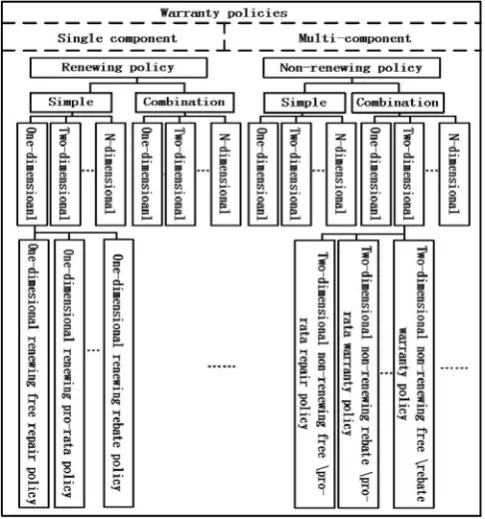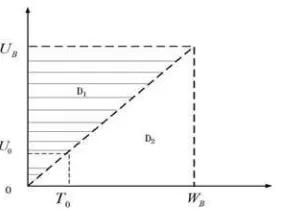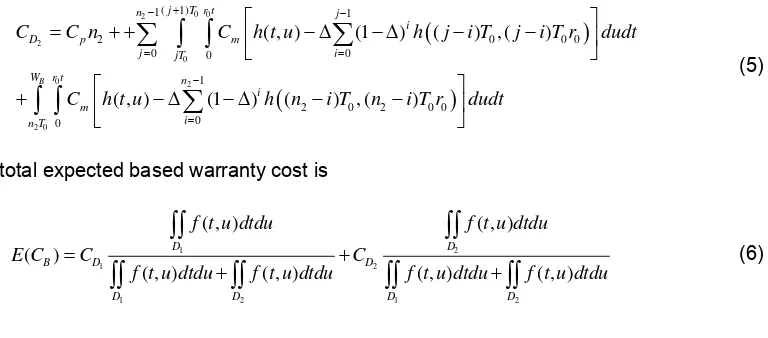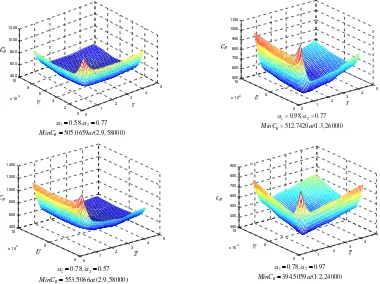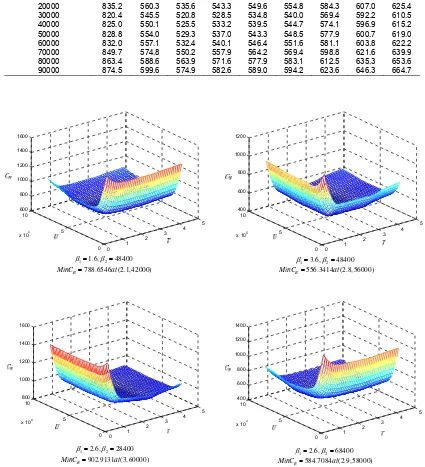DOI: 10.12928/TELKOMNIKA.v13i2.1455 722
Optimal Two Dimensional Preventive Maintenance
Policy Based on Asymmetric Copula Function
Xinyue Li*, Yunxian Jia, Zhen Li
Department of Management Engineering, Mechanical Engineering College Shijiazhuang, Hebei, China, Ph.:+8613930119296
*Corresponding author, e-mail: [email protected]
Abstract
For some kinds of products, the consumers have strict requirements to the reliability of these products in the based warranty period. Then the manufacturer is inclined to provide the two-dimensional preventive maintenance policy to take the usage degree of the product into account. As a result, two-dimensional preventive maintenance policy in the warranty period has recently obtained increasing attention from manufacturers and consumers. In this paper, we focused on the optimization of based warranty cost and proposed a new expected based warranty cost model considering the two-dimensional imperfect preventive maintenance policy from the perspective of the manufacture. Asymmetric copula function was applied to modeling the failure function of the product. And the optimal two-dimensional preventive maintenance period was obtained by minimizing based warranty cost. At last, numerical examples are given to illustrate the proposed models, of which the results prove the model effective and validate.
Keywords: Based Warranty, Two-Dimensional Preventive Maintenance, Asymmetric Copula Function
1. Introduction
In general, warranty has two significant roles as protector to consumers and promoter to manufacturer when the products fail to perform their pre-specified functions during the warranty period. According to Murthy and Blischke [1], there are only two kinds of warranty in the product life cycle including based warranty and extended warranty. Based warranty is sold with product. Its cost is usually included in the sale price. However, to have extended warranty, the customer should pay extra money to get the service after based warranty expires. Nowadays, either for based warranty or extended warranty, one key issue of interest that arises from warranty analysis is the modeling of warranty cost. By optimizing warranty cost, the manufacturer could price the warranty proper and make their product more attractive to consumers. One of the possible ways to achieve the above goal is by making optimal decision on the maintenance strategies in the warranty period. In the literature, maintenance is mainly classified into two types: corrective maintenance (CM) and preventive maintenance (PM) [2]. If the useful life of a product is relatively short, like lamp bulb, then its warranty is also relatively short and warranty servicing should involve only CM actions. If a product has a long useful life or needs high availability, like military equipment, then its warranty is relatively long and manufacturer can reduce warranty servicing costs and improve its performance by performing effective PM actions. Maintenance is therefore significant in the warranty context since it has a major impact on expected warranty servicing cost.
analytical or numerical methods have been reported in the literature so far, which offers a decision framework to optimize the two-dimensional preventive maintenance period in the warranty period. In this perspective, we develop in this paper a new mathematical model to find the optimized preventive maintenance policy for based warranty from the perspective of manufacturer. The rest of this paper is organized as follows: Section 2 introduces the relative work existing in the literature with product warranty policies. Section 3 outlines the model assumptions and notation. Section 4 is dedicated to development of the mathematical model. A numerical example illustrates our approach to prove the model validate and effective in Section 5.
2. Literature Review
Different warranty policies has different warranty cost. The characteristics of warranty policies are essential factors in determining warranty cost including warranty service object, maintenance task, warranty renewal mechanism and warranty dimension etc. Blischke and Murthy [3] formulated a classic taxonomy for warranty policies. But when the products are becoming more complex, the warranty policies have some changes. So based on the system of the warranty policies [4]-[6], we further develop the taxonomy for warranty policies to review the current literatures, shown as Figure 1.
Figure 1. The classification of warranty policies
the warranty period [13], and different warranty policies will be applied in the period of combined warranty policy [14]. According to the warranty boundaries, the warranty policies could be further divided into one-dimensional warranty, two-dimensional warranty and n-dimensional warranty (n≥3). One-dimensional warranty is limited by time [15], and two-dimensional warranty is usually limited by age and usage (such as miles and revolutions) [16]-[18]. For some complex products, which require high reliability, multi usage limits will be applied to restrain the warranty period. Then the warranty could be dimensional warranty. There are few literatures about n-dimensional warranty. However, along with the industrial product become more complex, the interesting of the n-dimensional warranty would increase. Obviously warranty policy is the result of the game between manufacturer and consumer. So the cost allocation mechanism will greatly influence the warranty decision and effect. And the warranty policy could be further divided into free-repair warranty, pro-rate warranty and rebate warranty etc by cost allocation mechanism. The manufacturer will take all expense in the free-repair warranty period. On the contrary, the warranty cost will be share by manufacturers and consumers in the period of pro-rata warranty or rebate warranty [19].
Obliviously, two-dimensional warranty is one of the main contents of the warranty policy For two-dimensional warranty, there are three methods that has been developed for analyzing two-dimensional warranty [20], ie univariate method [21]-[23], bivariate method [24] and time scale method [25]。Bivairate method is simpler and more straightforward. And one way to formulate the bi-variants distribution is making full use of Copula function. Copulas are a tool for constructing multivariate distributions and describing the dependence between random variables Furthermore symmetric copula function were already applied to model the product reliability. In this paper, we propose the cost model of the two-dimensional preventive maintenance in the warranty period by utilizing asymmetric copula function. And the optimal two-dimensional preventive maintenance period is obtained by minimizing the warranty cost. The advantages of the model proposed are as follows.
- It is able to handle the tail dependence of age and usage to calculate two-dimensional warranty cost which could be more accurate. The asymmetric copula function is applied rather than assuming the age and usage have linear relationship.
- The two-dimensional preventive maintenance period could be obtained by minimizing based warranty cost. It is more realistic that the PM action is also two-dimensional to make the product more reliable.
3. Model consideration
This section provides model consideration and some preliminary results. Throughout this paper, we assume imperfect preventive maintenance and minimal corrective maintenance. Compared to the mean time between failures, the maintenance time is negligible. A failure can be detected immediately which results in an immediate claim, then the manufacturer will respond all the claims. Assuming a failure could be detected immediately which results in an immediate claim and the manufacturer will respond all the claims. Notations as follow:
(T0, U0) : The two-dimensional preventive maintenance (PM) period implemented
(WB, UB) : The based warranty time and usage limit and
0 0 0
B
B
U U
r
W T
(0
1)
: PM level. When
1
, PM is perfect maintenance. When
0
, PM isminimal repair.
Cp : The cost of PM
Cm : The cost of CM
Assuming the usage of the product is relatively steady for individual customer. It doesn’t mean the usage for individual customer doesn’t change but change little. The based warranty coverage area could be divided into two parts: D1 and D2 shown as Figure 2. For D1, warranty is
likely terminated at usage limit. On the contrary, warranty is likely terminated at time limit for D2.
maintenance cost. The cumulative failure distribution function, failure density functions and failure rate of the product are [20]:
1 2
0 1 2 1 1 2 2 1 2 2
2 1 3 1 2 3
( , ) ( ( ), ( ), )
( ( ), ( ), ) (1, ( ), ) (1 ( ), ( ), )
( ( ),1, ) ( ( ),1 ( ), ) ,
( , ) ( , )
( , ) , ( , ) 1 ( , )
F t u C F t F u
p C F t F u p C F u C F t F u
p C F t C F t F u
F t u F t u
f t u h t u F t u
t u t u
(1)
whereC F t F u( 1( ), 2( ), ) is the asymmetric copula function and
2 0
1 i i
p
. C F t F u( 1( ), 2( ),1)is symmetric copula function and composed by symmetric copula. The common simple symmetric copula functions include Gaussian copula, t-copula, Gumbel copula, Clayton copula and Frank copula etc. Gumbel copula is:
1/
'
1 2 1 2
( ( ), ( ), ) exp ( ln( ( )) ( ln( ( ))
C F t F u F t F u (2)
Asymmetric copula function could handle tail dependence between time and usage in a given direction, which could be applied in modeling reliability data. Based on the collected data, we could easily estimate the parameters of F t F u1( ), 2( ) which are marginal distributions.
Figure 2. Two dimensional warranty coverage
4. Analytical warranty cost analysis
For the two-dimensional imperfect preventive policy, the failure rate right after performing the jth PM action is given by Eq. (4). Obviously, the PM action effect is the reduction of failure intensity [26]. n1 U UB 0,n2 W TB 0(
*
: Integer part of a real number).0 0 0 0 0
0 0 0 0 0
PM at ( , ) (1 ) ( , )
PM at (t, ) (1 ) ( / , )
jT h jT u h jT jT r
jU h jU h jU r jU
j=1,2,… (3)
For two-dimensional warranty, there are two possible situations that basic warranty expires. One is the usage of the product exceeds the mileage limitation. And the other is the age of the product exceeds the time limitation. So the warranty cost includes two parts: D1 and
D2. For the warranty coverage of D1, let Nt be the number of PM observed up to time t. Then the
failure rate between two PM action is:
t
N 0, h t u( , );
t
t
N j,
1
0
0
0 0
( )
( , ) (1 ) , ( )
j
i
i
j i U
h t u h j i U
r
The cost of the warranty including two-dimensional imperfect preventive maintenance is:
0 0 1 1 0 0 1 1 0 ( 1) 1 1 0 1 0
0 0 0 0
1 1 0 1 0 0 0 0 ( )
( , ) (1 ) , ( )
( )
( , ) (1 ) , ( )
B
j U u r
n j
i
D p m
j jU i
u r U n i m i n U
j i U
C C n C h t u h j i U dtdtu
r
n i U
C h t u h n i U dtdtu
r
(4)At the same principle, the cost of the warranty including two-dimensional imperfect preventive maintenance for the warranty coverage of D2 is:
0 0 2 2 0 0 2 2 0 ( 1) 1 12 0 0 0
0 0 0
1
2 0 2 0 0 0
0
( , ) (1 ) ( ) , ( )
( , ) (1 ) ( ) , ( )
B
j T r t
n j
i
D p m
j jT i
r t W n i m i n T
C C n C h t u h j i T j i T r dudt
C h t u h n i T n i T r dudt
(5)So the total expected based warranty cost is
1 2
1 2
1 2 1 2
( , ) ( , )
( )
( , ) ( , ) ( , ) ( , )
D D
B D D
D D D D
f t u dtdu f t u dtdu
E C C C
f t u dtdu f t u dtdu f t u dtdu f t u dtdu
(6)5. Numerical example
We use the asymmetric copula proposed by Wu [20]. The symmetric copula function which is applied to construction the asymmetric copula is
1 2 1 2 0 1 2
( ( ), ( )) ( ) ( ) 1 (1 ( ),1 ( ))
C F t F u F t F u C F t F u .
whereC x y0( , ) exp
ln( )x
ln( )y
1/
is the Gumbel copula. Suppose
p
C 150, Cm 820 and 0.36. The based warranty and extended warranty coverage are (5, 100000) and (10, 200000). The life of the product is(30, 600000). p0 0.9,p10.1,13.76
and 2 0.48,10.78, 20.77, 12.6,248400. The marginal cumulative failure distributions are:
1
1
1
( ) 1 exp t
F t , 2 2 2
( ) 1 exp u
F u
In the based warranty, the optimal preventive maintenance period could be obtained by minimize the based warranty shown as Figure 3. The optimal warranty cost is 513.1398 when the preventive maintenance period is (1.2, 24000). Partial results of the Figure 3 are shown as Table 1. We could find the warranty cost will decreases at first then increases with the increasing of T0 or U0.
change more by increasing
1 and
2. And the optimal warranty cost is increasing when
1isincreasing. On the contrary, it is decreasing when
2is increasing. We come to the conclusionthat
1and
2 have opposite influence on the based warranty cost.0 1
2 3
4 5
0 5
10 x 104
500 600 700 800 900 1000 1100
Figure 3. Warranty cost curve of different two-dimensional preventive maintenance period
0 1
2 3
4 5
0 2 4 6 8 10
x 104 400 600 800 1000 1200
1 0.58, 2 0.77
505.0659 (2.9,58000) B
MinC at
0 1 2 3
4 5
0 5 10
x 104 500 600 700 800 900 1000 1100
1 0.98, 2 0.77
512.7420 (1.3, 26000) B
MinC at
0
1 2
3 4
5
0 5 10
x 104 400 600 800 1000 1200 1400
1 0.78, 2 0.57
553.5066 (2.9, 58000)
B
MinC at
0 1
2 3
4 5
0 5 10
x 104 300 400 500 600 700 800 900
1 0.78, 2 0.97
394.5059 (1.2, 24000) B
MinC at
Figure 4. Sensitive analyze of based warranty cost model considering different
Then we analyze the sensitive of the based warranty cost model by changing
shownas Figure 5. And the optimal warranty cost is decreasing when
1 and
2is increasing. WeTable 1. Warranty cost of different two-dimensional preventive maintenance period
0.5 1.0 1.5 2.0 2.5 3.0 3.5 4.0 4.5
10000 1000.7 725.8 701.2 708.8 715.2 720.4 749.8 772.5 790.9 20000 835.2 560.3 535.6 543.3 549.6 554.8 584.3 607.0 625.4 30000 820.4 545.5 520.8 528.5 534.8 540.0 569.4 592.2 610.5 40000 825.0 550.1 525.5 533.2 539.5 544.7 574.1 596.9 615.2 50000 828.8 554.0 529.3 537.0 543.3 548.5 577.9 600.7 619.0 60000 832.0 557.1 532.4 540.1 546.4 551.6 581.1 603.8 622.2 70000 849.7 574.8 550.2 557.9 564.2 569.4 598.8 621.6 639.9 80000 863.4 588.6 563.9 571.6 577.9 583.1 612.5 635.3 653.6 90000 874.5 599.6 574.9 582.6 589.0 594.2 623.6 646.3 664.7
0 1
2
3 4
5
0 5
10 x 104 600 800 1000 1200 1400 1600
1 1.6, 2 48400
788.6546 (2.1, 42000)
B
MinC at
0
1 2
3 4
5
0 5
10 x 104
400 600 800 1000 1200
1 3.6, 2 48400
556.3414 (2.8,56000) B
MinC at
0 1
2 3
4 5
0 5
10 x 104
800 1000 1200 1400 1600
1 2.6, 2 28400
902.9131 (3, 60000) B
MinC at
0 1
2 3
4 5
0 5
10 x 104 400 600 800 1000 1200 1400
1 2.6, 2 68400
584.7084 (2.9, 58000) B
MinC at
Figure 5. Sensitive analyze of based warranty cost model considering different
6. Conclusions
This article proposes a method to find optimal two-dimensional preventive maintenance period by minimizing the warranty cost based on asymmetric copula function. The method proposed could help the manufacturer to price the based warranty properly. Many extensions to this work may be considered. The method of failure reduction models have to be further investigated. And the parameters of copula function have to be theoretically studied. In order to check models validity, some goodness-of-fit tests should be developed. At last, imperfect corrective maintenance should be included in these models.
U0
References
[1] Blischke WR, Murthy DNP. Product warranty management-I: A taxonomy for warranty policies.
European Journal of Operational Research. 1992; 62(2): 127-148.
[2] Mohamed BD, Salih OD, Abdul R. Handbook of Maintenance Management and Engineering. Springer. 2005.
[3] Blischke WR, Murth y DNP. Warranty Cost Analysis. CRC Press. 1993. [4] Blischke WR, Murthy DNP. Product Warranty Handbook. CRC Press. 1995.
[5] Murthy DNP, Blischke WR. Warranty management and product manufacture. Springer. 2006.
[6] Shafiee M, Chukova S. Maintenance models in warranty: A literature review. European Journal of Operational Research. 2013; 229(3): 561-572.
[7] Chukova S, Arnold R, Wang DQ. Warranty analysis: An approach to modeling imperfect repairs.
International Journal of Production Economics. 2004; 89(1): 57-68.
[8] Huang YS, Zhuo YF. Estimation of future breakdowns to determine optimal warranty policies for products with deterioration. Reliability Engineering & System Safety. 2004; 84(2): 163-168.
[9] Bai J, Pham H. Cost analysis on renewable full-service warranties for multi-component systems.
European Journal of Operational Research. 2006; 168(2): 492-508.
[10] Park M, Pham H. Altered quasi-renewal concepts for modeling renewable warranty costs with imperfect repairs. Mathematical and Computer Modelling. 2010; 52(9): 1435-1450.
[11] Bai J, Pham H. Repair-limit risk-free warranty policies with imperfect repair. IEEE Transactions on
Systems, Man and Cybernetics, Part A: Systems and Humans. 2005; 35(6): 765-772.
[12] Wu S, Longhurst P. Optimising age-replacement and extended non-renewing warranty policies in lifecycle costing. International Journal of Production Economics. 2011; 130: 262–267.
[13] Park M, Pham H. Warranty cost analyses using quasi-renewal processes for multicomponent systems. IEEE Transactions on Systems, Man and Cybernetics, Part A: Systems and Humans. 2010; 40(6): 1329-1340.
[14] Jack N, Iskandar B P, Murthy D N P. A repair–replace strategy based on usage rate for items sold with a two-dimensional warranty. Reliability Engineering & System Safety. 2009; 94(2): 611-617. [15] Park M, Pham H. A new warranty policy with failure times and warranty servicing times. IEEE
Transactions on Reliability. 2012; 61(3): 822-831.
[16] Chen T, Popova E. Maintenance policies with two-dimensional warranty. Reliability Engineering & System Safety. 2002; 77(1): 61-69.
[17] Chukova S, Johnston MR. Two-dimensional warranty repair strategy based on minimal and complete repairs. Mathematical and computer modelling. 2006; 44(11): 1133-1143.
[18] Varnosafaderani S, Chukova S. A two-dimensional warranty servicing strategy based on reduction in product failure intensity. Computers & Mathematics with Applications. 2012; 63(1): 201-213.
[19] Chien YH. The effect of a pro-rata rebate warranty on the age replacement policy with salvage value consideration. IEEE Transactions on Reliability. 2010; 59(2): 383-392.
[20] Wu S. Construction of asymmetric copulas and its application in two-dimensional reliability modelling.
European Journal of Operational Research. 2014; 238(2): 476-485.
[21] Yun WY, Kang KM. Imperfect repair policies under two-dimensional warranty. Proceedings of the Institution of Mechanical Engineers, Part O: Journal of Risk and Reliability. 2007; 221(4): 239-247. [22] Iskandar BP, Murthy DNP, Jack N. A new repair–replace strategy for items sold with a
two-dimensional warranty. Computers & Operations Research. 2005; 32(3): 669-682.
[23] Huang YS, Zhuo YF. Estimation of future breakdowns to determine optimal warranty policies for products with deterioration. Reliability Engineering & System Safety. 2004; 84(2): 163-168.
[24] Chen T, Popova E. Maintenance policies with two-dimensional warranty. Reliability Engineering & System Safety. 2002; 77(1): 61-69.
[25] Gertsbakh IB, Kordonsky KB. Parallel time scales and two-dimensional manufacturer and individual customer warranties. IIE transactions. 1998; 30(12): 1181-1189.
